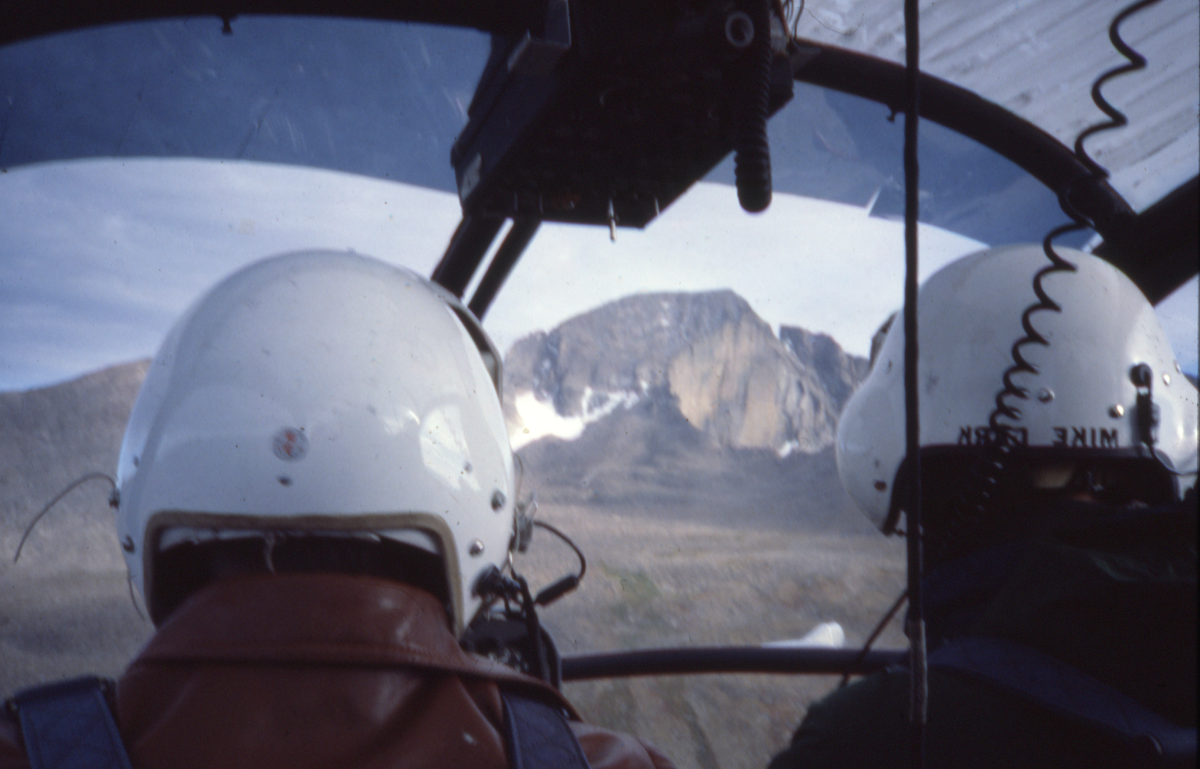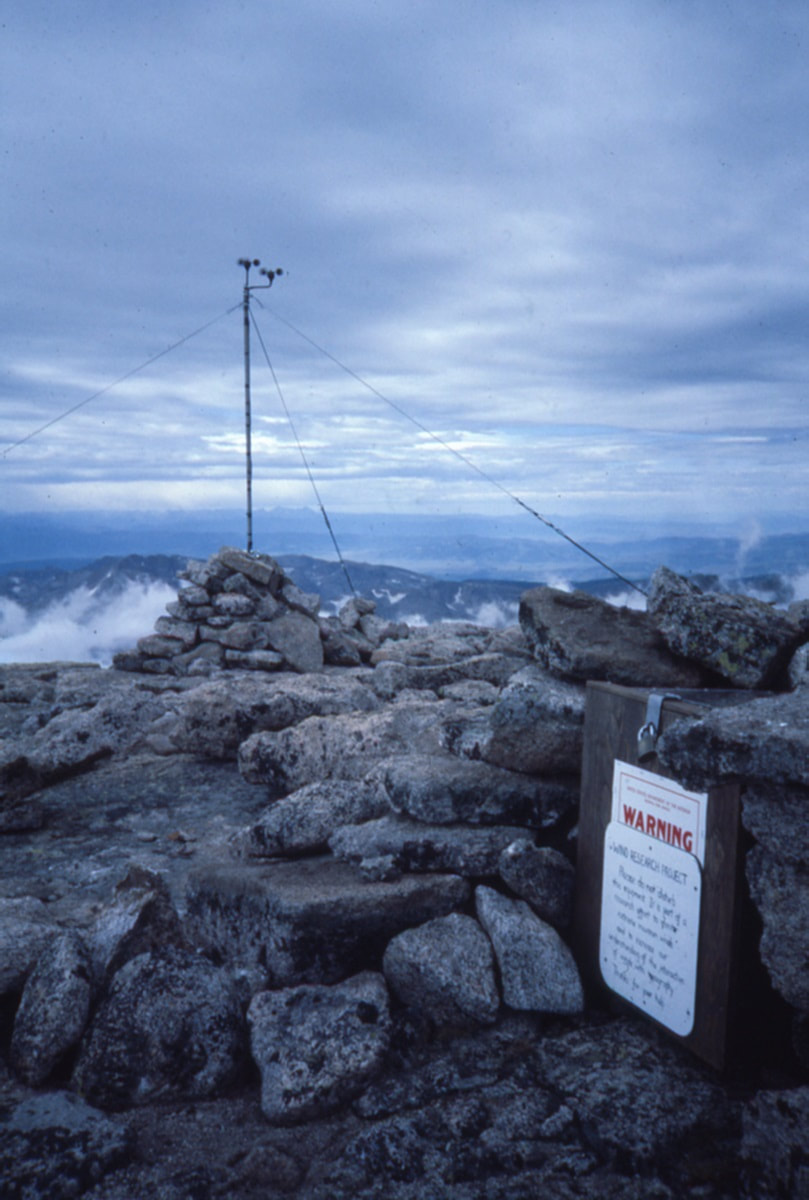|
Memoir and photos by Chris Revely Author's NoteMy next few contributions to HIKE ROCKY are based on recollections of four years of employment with the National Park Service (1978 – '81), served mostly around Longs Peak. These memories are vivid. But are they completely true? In the late 1970s, rumors of high winds around Estes Park had reached the East Coast. Meteorologists working on Mount Washington in New Hampshire, where a long-standing world-record wind speed of 234 mph was measured, wondered if that record might be broken along the Continental Divide in Rocky Mountain National Park. As a Longs Peak backcountry ranger, I was recruited to assist with the construction of a wind measuring device on the summit of Longs Peak. Later, the project would require more extensive, personal involvement. In the Fall of 1980 (or was it '81? See authors note) personnel and equipment were assembled at an often-used staging area along the upper Beaver Meadows road. The helicopter arrived and over two days, we made several flights loaded with tools and materials to the summit of Longs Peak . Having proudly struggled to the summit of Longs scores of times under my own power, the experience of rising, effortlessly, in one unbroken line of ascent from the take-off point to the top was both exhilarating and eerily disturbing. My thoughts toggled back and forth between, “WOW!!! What an amazing machine” and “There is just something wrong about getting to the top of Longs like this.” On the flat summit about 100 yards northwest of the often-visited high point, a solid metal mast with its spinning anemometer attached, was secured in a vertical position with several heavy-gauge steel wires tightly anchored to large rocks. Thin transmission wires wound down the post and reached the recording apparatus near the base. We were assured by the Mount Washington team that this arrangement could withstand anything the atmosphere might dish out. As a resident Park Ranger at the Longs Peak trailhead that year, I was unanimously elected (at a meeting I don't recall attending) to service the wind measuring apparatus throughout the winter. It was a project I naively and enthusiastically embraced due in part to the competitive verve that had sprung up around the project. Could Longs Peak beat Mount Washington? Data from the anemometer would be recorded by a stylus on paper if - and only if - the tension spring that turned the paper's cylinder was wound up regularly, like winding an old-fashion grandfather clock. The winding, I was told, should take place once weekly (?!!). The magnitude of the project and my responsibility became disturbingly clear: it would entail frequent trips to the mountain's summit from the Longs Peak trailhead, throughout the winter. Success would depend on regular, reasonable climbing conditions on twenty separate days, from November through March. (Hmmmm….. lots of unspoken ifs in that plan). The winding of the apparatus was achieved with a metal wrench. I would have to remove my heavy, outer mittens and execute the essential maneuver wearing little or nothing on my hands while being slapped around by icy gusts on the exposed plateau. I knew that conditions around the summit would sometimes be so extreme as to preclude reaching the contraption, much less performing the necessary activities out in the open. A plywood coffin-like structure was designed, built and snuggly fitted up against the recorder. Entry to the long narrow box was made through the opposite end, which was fitted with a hinged door. This seemed to solve the problems of access and protection. Once weekly, I left the trailhead with plenty of clothing, food and water. I carried two ice-climbing tools, crampons, a light rope and a few pieces of gear to a place of protection in case conditions on my preferred approach (the North Face) required self-belay. Once past the technical difficulties of the old Cables route, the remainder of the climb involved only kicking steps in snow and finding my way over and around large boulders to the edge of the summit plateau. From there, the last leg of the approach resembled trench warfare. At just the right moment, having waited for a break between volleys of wind, I would break into the open, fully exposed to fire from the enemy, and proceed, crab-like, zigzagging on hands and feet to the coffin, my only point of cover. Once inside, I could relax and take care of business. That winter, between November and late February, I reached the summit (of Longs) on fewer than half of my attempts. My journey to the top always started with the best intentions but often ended in a hail of flying gravel and battering wind below the Chasm View overlook. While the recorder waited patiently for its recharge, I wound it up, more often than not, laying on my side, curled on the floor of a body-size crack below the North Face, laughing at the absurdity of my pitiful situation. At those moments, the decision was easy; if I can't go on safely, it’s time to go down. Turn around at any point on that route and it is all downhill and down-wind to the trailhead. The irony of my situation was, however, harder to escape: There I lay, defeated by extreme wind, the very phenomenon we were most hoping to record. Throughout the winter, I the reached the site when I could and information continued to be collected. Sometime in late February, the steel mast came down and wires were scattered across the summit by (of course) high wind. On New Hampshire's Mount Washington, weather data is collected throughout the year from instruments mounted atop bunker-like, reinforced buildings. Weather station employees travel to the 6,288-foot summit in heated snowcats, spending several days in residence reading instrument gauges while sipping coffee in heated work areas. By comparison, our approach to the hunt for high wind on the 14,256-foot summit of Longs Peak was laughably inadequate; poorly conceived, badly executed and doomed to failure from the beginning. Longs Peak did not officially win the wind speed contest. But I'm not entirely sure it lost. We will never know exactly how much faster the wind blew after the equipment was flattened. Is it worth another try? Today, with improved technology, more sophisticated equipment and a better understanding of wind dynamics around surface features, the odds of success would certainly improve. I suspect there may still be world-record wind waiting to be found among the high peaks of Rocky Mountain National Park. Read a brief synopsis of the wind research project on Rocky Mountain National Park’s website; and, DE Glidden’s report on this project, which was funded by the Rocky Mountain Conservancy is also available online.  Chris Reveley has spent 50 years climbing and doing endurance sports; and, thirty years learning and practicing medicine. “Now I’m a Happy House Husband with hobbies,” he said. The publication of this story was made possible by Images of RMNP and Brownfields.
0 Comments
Leave a Reply. |
Categories
All
|
© Copyright 2025 Barefoot Publications, All Rights Reserved




